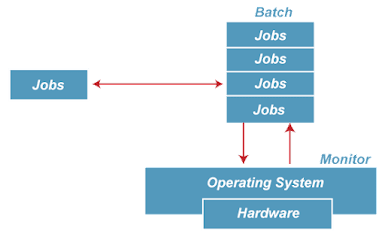Types of Operating Systems (OS):
An operating system is a well-organized collection of programs that manages the computer hardware. It is a type of system software that is responsible for the smooth functioning of the computer system.
Batch Operating System:
In the 1970s, Batch processing was very popular. In this technique, similar types of jobs were batched together and executed in time. People were used to having a single computer which was called a mainframe.
In Batch operating system, access is given to more than one person; they submit their respective jobs to the system for the execution.
The system put all of the jobs in a queue on the basis of first come first serve and then executes the jobs one by one. The users collect their respective output when all the jobs get executed.
The purpose of this operating system was mainly to transfer control from one job to another as soon as the job was completed. It contained a small set of programs called the resident monitor that always resided in one part of the main memory. The remaining part is used for servicing jobs.
Advantages of Batch OS:
- The use of a resident monitor improves computer efficiency as it eliminates CPU time between two jobs.
Disadvantages of Batch OS:
Batch processing suffers from starvation.
There are five jobs J1, J2, J3, J4, and J5, present in the batch. If the execution time of J1 is very high, then the other four jobs will never be executed, or they will have to wait for a very long time. Hence the other processes get starved.
2. Not Interactive:
Batch Processing is not suitable for jobs that are dependent on the user's input. If a job requires the input of two numbers from the console, then it will never get it in the batch processing scenario since the user is not present at the time of execution.



